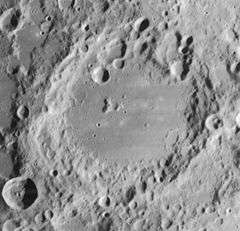Longomontanus (crater)
Longomontanus is an ancient lunar impact crater located in the rugged southern highlands to the southwest of the bright ray crater Tycho. Longomontanus is of the variety of large lunar formations called a "walled plain", although it is actually more of a circular depression in the surface.
 Lunar Orbiter 4 image | |
| Coordinates | 49.5°S 21.7°W |
|---|---|
| Diameter | 145 km |
| Depth | 4.5 km |
| Colongitude | 22° at sunrise |
| Eponym | C. S. Longomontanus |
Because of its location, Longomontanus appears distinctly oval in shape due to foreshortening. To the southeast of Longomontanus is the even larger formation Clavius, and to the east is Maginus. North of the rim is the irregular crater Montanari, which in turn is joined at its northern rim by Wilhelm.
The wall of Longomontanus is heavily worn and incised by past impacts, and the rim is essentially level with the surrounding terrain. The northern rim especially is impacted with multiple overlapping craterlets. To the east of the rim is a semi-circular ridge that has the appearance of an overlapped crater rim. The crater floor of Longomontanus is relatively flat, with a low cluster of central peaks somewhat offset to the west.
Satellite craters
By convention these features are identified on lunar maps by placing the letter on the side of the crater midpoint that is closest to Longomontanus.
| Longomontanus | Latitude | Longitude | Diameter |
|---|---|---|---|
| A | 52.8° S | 24.0° W | 29 km |
| B | 52.9° S | 20.7° W | 48 km |
| C | 53.4° S | 19.0° W | 31 km |
| D | 54.3° S | 22.9° W | 29 km |
| E | 51.4° S | 18.0° W | 8 km |
| F | 48.2° S | 23.5° W | 19 km |
| G | 48.7° S | 18.5° W | 15 km |
| H | 52.0° S | 23.2° W | 7 km |
| K | 47.9° S | 20.9° W | 15 km |
| L | 49.1° S | 23.6° W | 16 km |
| M | 48.6° S | 23.2° W | 10 km |
| N | 50.8° S | 25.7° W | 12 km |
| P | 48.1° S | 25.3° W | 7 km |
| Q | 52.0° S | 20.5° W | 11 km |
| R | 52.4° S | 26.1° W | 9 km |
| S | 47.4° S | 23.3° W | 12 km |
| T | 46.8° S | 22.7° W | 5 km |
| U | 52.0° S | 22.0° W | 7 km |
| V | 50.7° S | 18.9° W | 5 km |
| W | 47.1° S | 21.3° W | 10 km |
| X | 53.0° S | 17.7° W | 5 km |
| Y | 52.3° S | 28.2° W | 4 km |
| Z | 50.0° S | 18.7° W | 95 km |
References
- Andersson, L. E.; Whitaker, E. A. (1982). NASA Catalogue of Lunar Nomenclature. NASA RP-1097.CS1 maint: ref=harv (link)
- Blue, Jennifer (July 25, 2007). "Gazetteer of Planetary Nomenclature". USGS. Retrieved 2007-08-05.CS1 maint: ref=harv (link)
- Bussey, B.; Spudis, P. (2004). The Clementine Atlas of the Moon. New York: Cambridge University Press. ISBN 978-0-521-81528-4.CS1 maint: ref=harv (link)
- Cocks, Elijah E.; Cocks, Josiah C. (1995). Who's Who on the Moon: A Biographical Dictionary of Lunar Nomenclature. Tudor Publishers. ISBN 978-0-936389-27-1.CS1 maint: ref=harv (link)
- McDowell, Jonathan (July 15, 2007). "Lunar Nomenclature". Jonathan's Space Report. Retrieved 2007-10-24.CS1 maint: ref=harv (link)
- Menzel, D. H.; Minnaert, M.; Levin, B.; Dollfus, A.; Bell, B. (1971). "Report on Lunar Nomenclature by the Working Group of Commission 17 of the IAU". Space Science Reviews. 12 (2): 136–186. Bibcode:1971SSRv...12..136M. doi:10.1007/BF00171763.CS1 maint: ref=harv (link)
- Moore, Patrick (2001). On the Moon. Sterling Publishing Co. ISBN 978-0-304-35469-6.CS1 maint: ref=harv (link)
- Price, Fred W. (1988). The Moon Observer's Handbook. Cambridge University Press. ISBN 978-0-521-33500-3.CS1 maint: ref=harv (link)
- Rükl, Antonín (1990). Atlas of the Moon. Kalmbach Books. ISBN 978-0-913135-17-4.CS1 maint: ref=harv (link)
- Webb, Rev. T. W. (1962). Celestial Objects for Common Telescopes (6th revised ed.). Dover. ISBN 978-0-486-20917-3.CS1 maint: ref=harv (link)
- Whitaker, Ewen A. (1999). Mapping and Naming the Moon. Cambridge University Press. ISBN 978-0-521-62248-6.CS1 maint: ref=harv (link)
- Wlasuk, Peter T. (2000). Observing the Moon. Springer. ISBN 978-1-85233-193-1.CS1 maint: ref=harv (link)
External links
- Wood, Chuck (December 30, 2007). "Splattered". Lunar Photo of the Day. Archived from the original on December 31, 2007. Retrieved 2008-01-02.